We’ve all experienced the frustration of smudged copies and paper jams at the worst possible moment. A clean copier isn’t just about aesthetics—it directly impacts your document quality and machine lifespan. In our office, we’ve discovered that regular maintenance doesn’t need to be complicated or time-consuming. Want to eliminate those mysterious lines on your copies and reduce those emergency service calls? The solution might be simpler than you think.
Expert Highlights
- Clean the glass surfaces weekly with a microfiber cloth using overlapping strokes to prevent document streaks.
- Use only recommended cleaning supplies like isopropyl alcohol and lint-free cloths to protect sensitive components.
- Maintain paper paths by removing dust with compressed air and cleaning feed rollers to prevent jams.
- Power off the copier before cleaning toner areas and use proper toner vacuums with HEPA filtration.
- Follow a regular maintenance schedule with weekly exterior cleaning and quarterly waste toner container checks.
Gathering the Right Cleaning Supplies
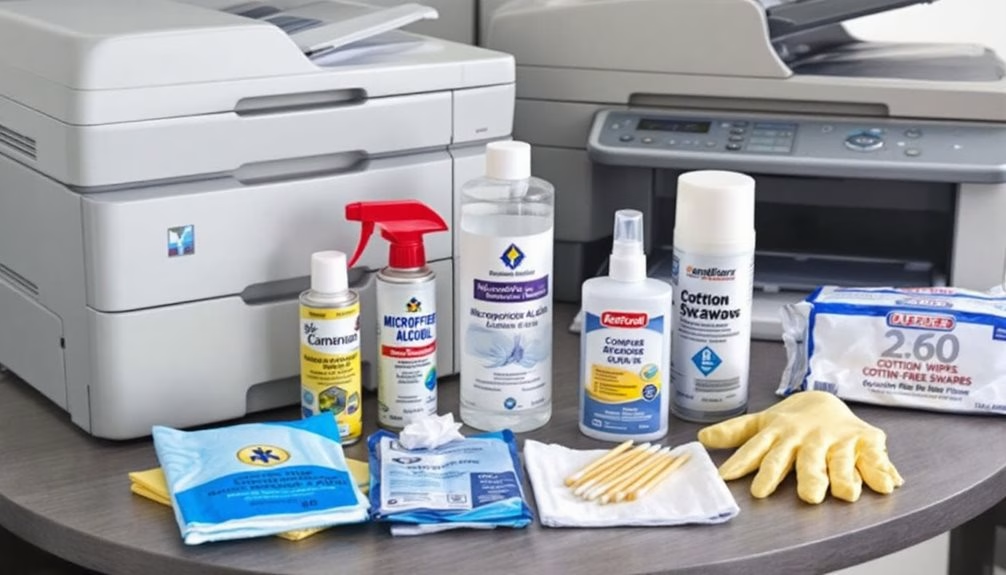
Before you tackle copier cleaning, gathering the proper supplies guarantees both effective results and protection for your machine.
We’ll need isopropyl alcohol (91%), lint-free microfiber cloths, compressed air, cotton swabs, and a small vacuum attachment.
Don’t substitute household cleaners—they can damage sensitive components.
We recommend wearing anti-static gloves to prevent transferring oils and static electricity to internal parts.
Let’s also prepare a small container for any waste toner and a clean workspace where we can place removed components.
Having everything ready before we start ensures we’ll complete the cleaning efficiently while keeping our office equipment in prime condition.
Regular cleaning is an essential part of preventive maintenance that helps avoid potential problems with your copier or MFD printer.
Cleaning the Glass and Document Feeder
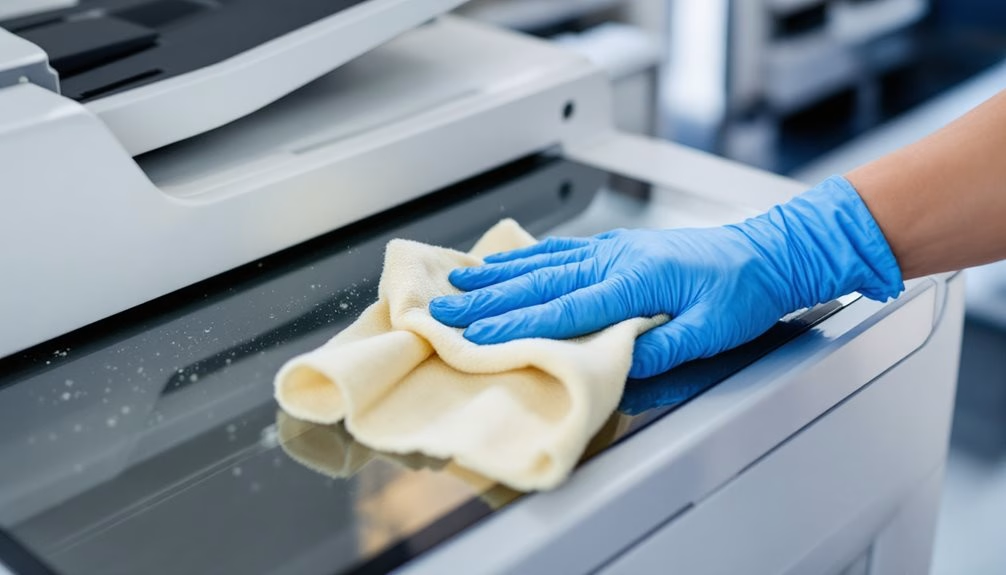
We’ll now focus on keeping your copier’s glass and document feeder spotless for ideal performance.
The glass requires special attention with microfiber cloths and gentle cleaners to achieve streak-free results, while the scanner bed needs regular dusting and removal of paper debris.
Don’t forget to clean the feeder rollers, as they frequently accumulate toner particles and paper dust that can transfer onto your documents.
For best results, schedule regular maintenance with our factory-trained technicians who can provide professional cleaning services with a guaranteed 4-hour response time.
Streak-Free Glass Techniques
The two most important parts of your copier to keep spotless are the glass scanning surface and document feeder.
For streak-free results, we recommend using a microfiber cloth with a small amount of ammonia-free glass cleaner. Always spray the cloth, never directly on the glass.
Wipe in one direction using overlapping strokes rather than circular motions. This technique prevents streaks that often appear when the cleaner dries. For stubborn smudges, apply gentle pressure with a clean section of your cloth.
Let the glass dry completely before using your machine. Remember, even minor streaks can appear on your copies.
Scanner Bed Maintenance
Regular scanner bed maintenance guarantees peak performance and extends your copier’s lifespan.
We recommend cleaning the scanner bed weekly or after high-volume jobs.
First, power down your machine completely. Gently wipe the glass surface with a microfiber cloth dampened with an approved cleaner. Don’t spray directly onto the glass—this prevents liquid from seeping into edges.
For document feeders, remove any paper clips or staples that might be stuck. Clean the feeder rollers with a slightly damp cloth to remove paper dust and toner residue.
We’re all trying to keep our office equipment running smoothly, and these simple steps guarantee crisp, clear copies every time.
Feeder Roller Care
Proper feeder roller care prevents most common paper jams and guarantees reliable document processing. We recommend cleaning these rollers monthly, especially in high-volume environments.
First, unplug your copier and locate the document feeder. Open the access panel to expose the rollers.
Using a microfiber cloth slightly dampened with isopropyl alcohol, gently wipe each roller while rotating it by hand. This removes paper dust, toner particles, and oils that accumulate over time.
For stubborn residue, increase pressure slightly, but never use harsh chemicals that might damage the rubber.
We’re all looking for efficiency in our workday—clean rollers help us achieve that together.
Removing Dust and Debris From External Surfaces
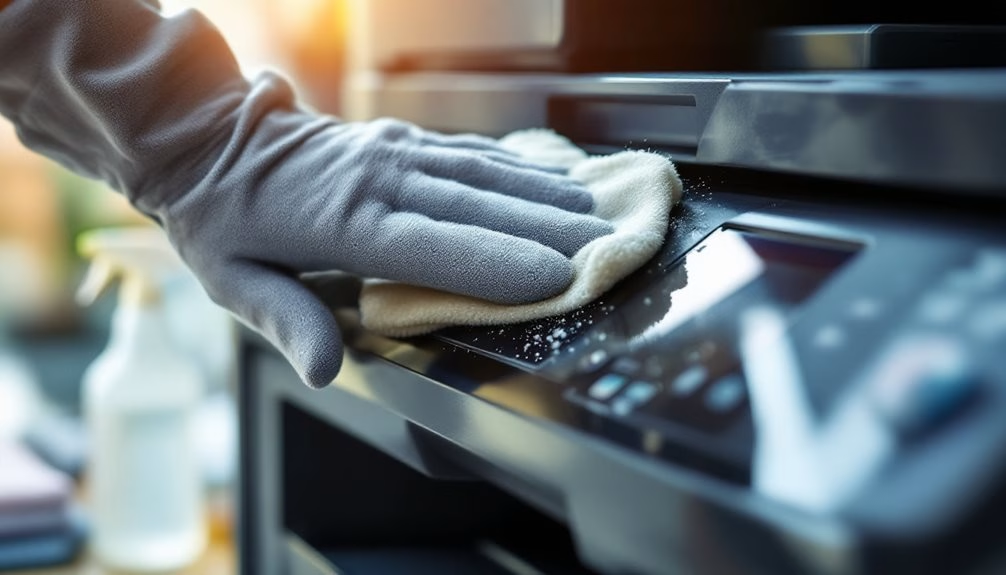
Keeping your copier’s external surfaces clean not only maintains a professional appearance but also prevents dust and debris from migrating to internal components.
We recommend using a microfiber cloth slightly dampened with a mild cleaning solution to wipe down the exterior panels, display screen, and control panel.
Don’t spray liquid directly onto the copier—it could seep into sensitive electronics. Instead, apply the cleaner to your cloth first.
Always apply cleaning solutions to your cloth rather than spraying directly on the copier to protect internal electronics from damage.
For stubborn spots, gently increase pressure rather than using harsher chemicals.
We should clean external surfaces weekly in dusty environments, or monthly in cleaner office settings.
Regular maintenance is particularly important for floor-standing models that tend to accumulate more dust due to their larger surface area and high-volume usage.
Addressing Paper Path and Roller Maintenance
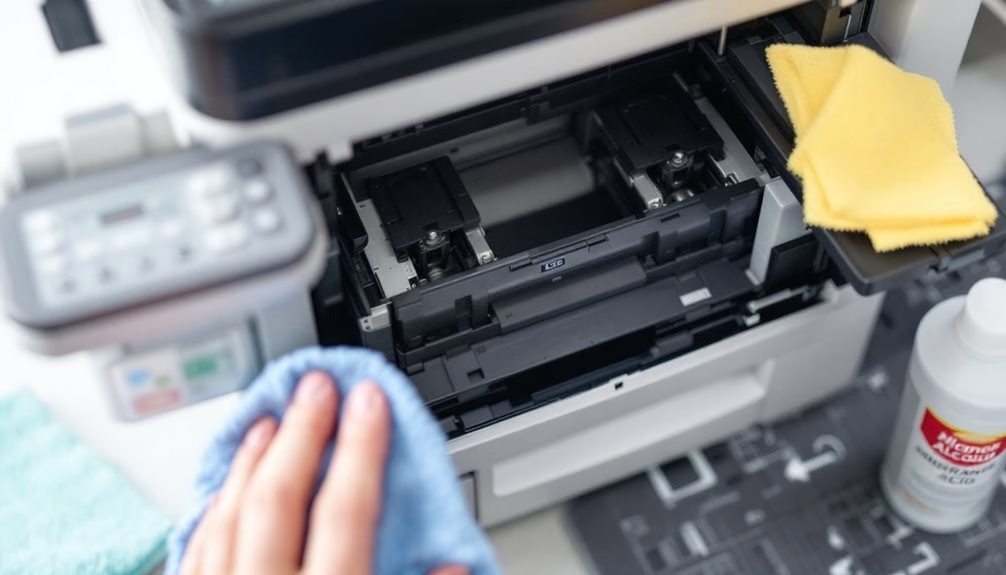
Let’s tackle the internal components that keep your copier running smoothly.
We’ll first remove accumulated dust from the paper path using compressed air.
Then clean feed rollers with an approved solvent to prevent paper jams.
Finally, we’ll inspect the entire feed path for torn paper fragments or foreign objects that might cause future problems.
Regular maintenance of these areas can prevent up to 70% of common problems with your copier and extend its operational lifespan.
Dust Removal Techniques
Dust particles, the silent saboteurs of your copier’s performance, regularly accumulate in the paper path and on rollers during normal operation.
We recommend using compressed air cans to blast away stubborn dust from hard-to-reach areas. Always hold the can upright to avoid spraying liquid.
For accessible surfaces, microfiber cloths work wonders without leaving lint behind.
Don’t forget about the scanner glass! We’ve found that a gentle glass cleaner and lint-free cloth can restore crystal-clear scanning capabilities. Remember to power down before cleaning.
Regular dust removal keeps our machines running smoothly.
When we tackle this maintenance together, we’ll extend our copier’s lifespan considerably.
2. Roller Cleaning Methods
The paper path rollers often suffer the most wear and tear in our copiers, requiring specialized attention beyond basic dust removal.
We’ve found that proper roller maintenance prevents paper jams and extends your machine’s lifespan.
To clean your copier’s rollers effectively:
- Dampen a lint-free cloth with isopropyl alcohol (avoid soaking) and gently rotate each roller while applying light pressure.
- Use rubber roller rejuvenator on hardened rollers that have lost their grip.
- Clean feed rollers monthly, but exit rollers quarterly since they collect less debris.
3. Feed Path Inspection
Properly inspecting your copier’s feed path requires three critical checkpoints to confirm smooth paper flow and prevent frustrating jams.
First, examine the entire paper path for debris or torn fragments that might obstruct movement. We’ve seen even tiny pieces cause major problems.
Next, check all guide plates and rollers for proper alignment. These components should be firmly seated without excessive wear. If you notice any wobbling or irregularities, it’s time for maintenance.
Finally, verify that sensors along the path are clean and unobstructed. These electronic eyes confirm your machine tracks paper accurately.
When we maintain these checkpoints regularly, we’ll enjoy fewer interruptions and longer copier life.
Toner Area Cleaning Best Practices
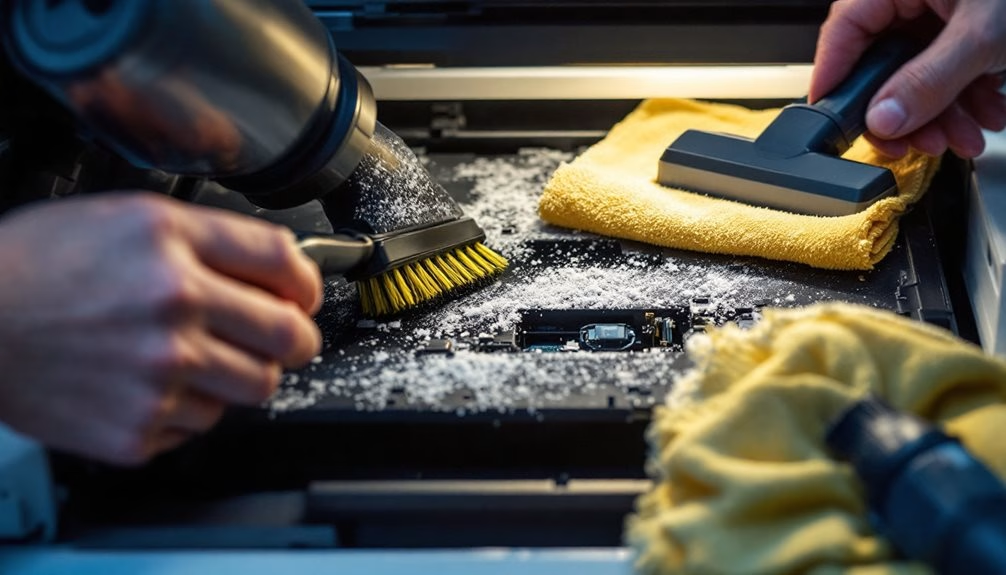
Three critical steps must be followed when cleaning your copier’s toner area to prevent damage and guarantee peak performance.
We’ve all experienced the frustration of toner spills, but with proper cleaning techniques, we’ll keep our machines running smoothly together.
- Always power off and unplug your copier before accessing the toner area.
- Use a toner vacuum with HEPA filtration, never compressed air which spreads particles.
- Gently wipe surfaces with lint-free cloths, moving from cleaner to dirtier areas.
Our certified technicians are always ready to provide expert assistance if you encounter persistent toner area issues.
Creating a Maintenance Schedule for Long-Term Care
Now that you’ve mastered proper toner area cleaning, let’s establish a consistent maintenance schedule for your copier.
We recommend weekly dusting of exterior surfaces and scanning glass to prevent document defects.
Monthly, perform a deep cleaning of paper paths and feed rollers.
Check and empty waste toner containers quarterly, and replace filters as needed.
Twice yearly, schedule professional maintenance for internal components that aren’t user-accessible.
This preventive care greatly extends your machine’s life.
Create a simple cleaning log near your copier to track completed tasks.
When we’re consistent with maintenance, we’ll enjoy fewer breakdowns and better print quality.
Frequently Asked Questions
Can I Use Household Cleaners Instead of Specialized Copier Cleaning Products?
We don’t recommend using household cleaners. They can damage your copier’s sensitive parts. Instead, we’ll suggest investing in specialized copier cleaning products that protect your machine’s longevity.
How Do I Clean a Color Copier’s Calibration Sensors?
We recommend using compressed air and lint-free cloths to gently clean color copier calibration sensors. Don’t use household cleaners—they’ll damage these delicate components. Always check your machine’s manual for specific instructions.
Will Cleaning Fix Streaks or Lines on My Copies?
We often find that cleaning can fix streaks or lines by removing dust, toner buildup, or debris from the glass, rollers, or drums. It’s our first troubleshooting step before considering repairs.
How Often Should Professional Servicing Replace DIY Maintenance?
We recommend professional servicing every 6-12 months. While our regular DIY cleaning helps with streaks and lines, professionals can address deeper issues we can’t tackle ourselves.
Can I Clean Internal Components if My Copier Has Poor Print Quality?
We don’t recommend accessing internal components yourself. Poor print quality usually signals it’s time for professional servicing. Let’s schedule a technician visit to restore your prints to their best.
Expert Final Thoughts
We’ve covered the essentials of copier maintenance from supplies to toner care. By following these steps regularly, you’ll extend your machine’s life and maintain print quality. Don’t forget to document your cleaning schedule and know when it’s time to call professionals. A well-maintained copier saves time, reduces frustration, and protects your investment for years to come.
About the Expert
Rafael M.
CEO of JR Copier
With over 35 years of hands-on experience in the copier and office printer industry, Rafael brings unparalleled expertise to every client interaction. His journey from service technician to CEO provides him with comprehensive understanding of all aspects of the business.
Areas of Expertise: Copier and printer sales, equipment leasing strategies, maintenance solutions, and managed print services. Rafael's deep industry knowledge ensures clients receive expert guidance, transparent pricing, and exceptional service for all their office equipment needs.
Connect on LinkedIn